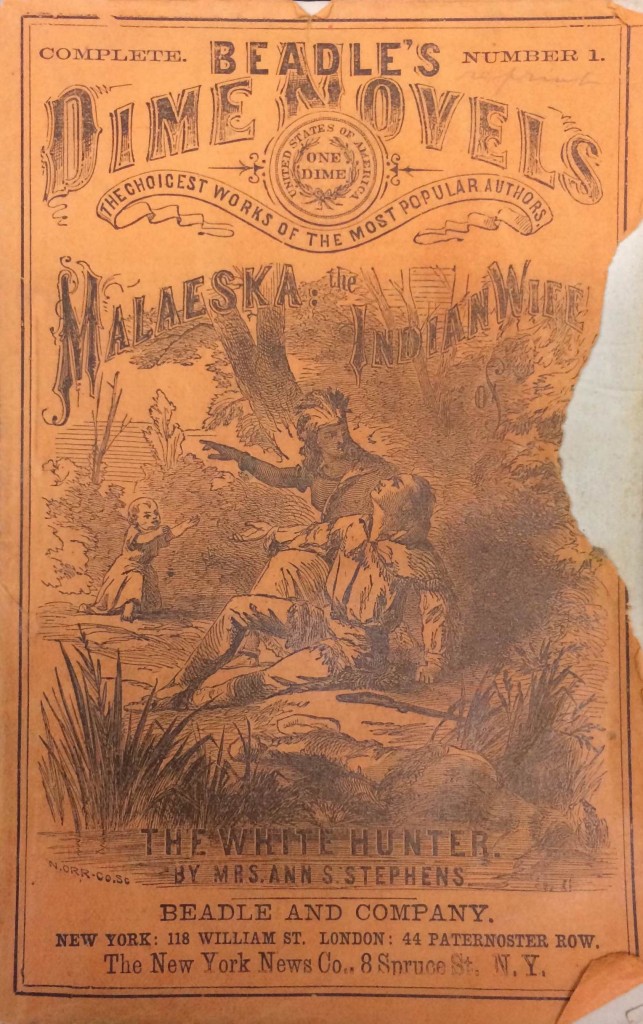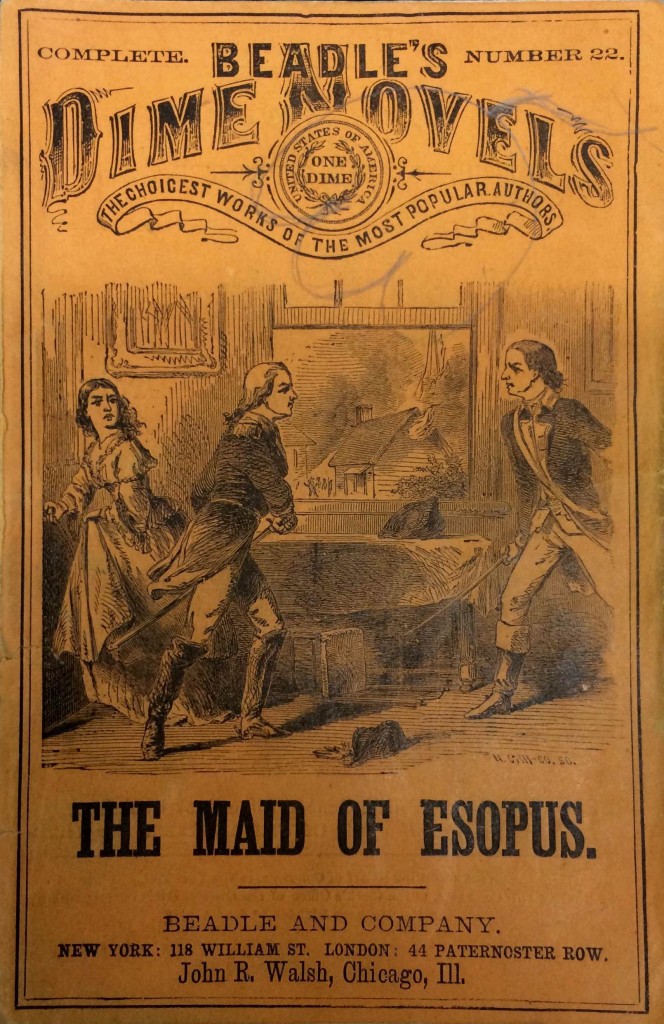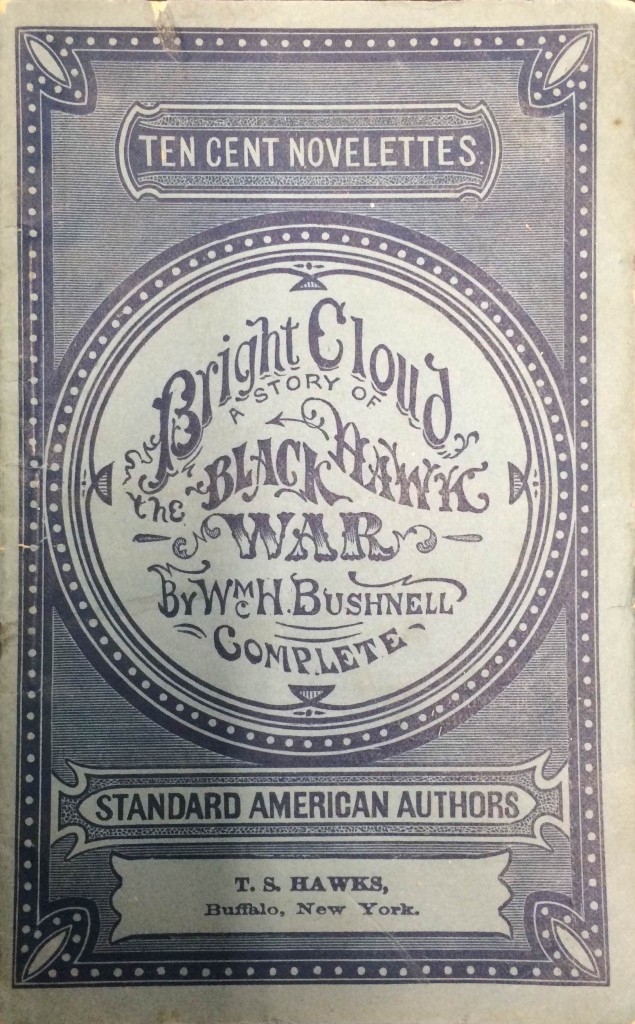“The intelligent American public will find in the Dime Publications of the house of Beadle and Company works which meet not only a great popular want of excellent books and cheap rates, but which are, in every respect, deserving of the wide popularity to which they have attained.”
– from ‘A word to those who desire good books,’ Beadle and Company.
 Dime novels were cheap publications (yes, many of them only cost ten cents) that flourished in the second half of the 1800s. It is generally accepted that the first dime novel was Malaeska, the Indian Wife of the White Hunter by Mrs. Ann S. Stephens, published by the firm of Irwin P. Beadle & Co. on June 9, 1860. Beadle & Adams, as the publishers were later known, became the preeminent publisher of dime works, and their success bred competition. Munro’s Ten Cent Novels, published by George Munro (who was briefly partnered with Irwin P. Beadle after he left his brother’s firm) and the Ten Cent Novelettes of Elliott, Thomes & Talbot were not as successful as Beadle’s publications, but all catered to a similar interest for romantic and sensational literature. These stories frequently featured Native Americans, either with early American colonists or the pioneers of the West; heroic exploits during the American Revolution; tales of shipwrecks along the coast and pirates in the Caribbean (beating Disney by over a century); orphan children and missing heirs; disinherited dukes in Italy and witch trials in Salem; and many, many sundered lovers.
Dime novels were cheap publications (yes, many of them only cost ten cents) that flourished in the second half of the 1800s. It is generally accepted that the first dime novel was Malaeska, the Indian Wife of the White Hunter by Mrs. Ann S. Stephens, published by the firm of Irwin P. Beadle & Co. on June 9, 1860. Beadle & Adams, as the publishers were later known, became the preeminent publisher of dime works, and their success bred competition. Munro’s Ten Cent Novels, published by George Munro (who was briefly partnered with Irwin P. Beadle after he left his brother’s firm) and the Ten Cent Novelettes of Elliott, Thomes & Talbot were not as successful as Beadle’s publications, but all catered to a similar interest for romantic and sensational literature. These stories frequently featured Native Americans, either with early American colonists or the pioneers of the West; heroic exploits during the American Revolution; tales of shipwrecks along the coast and pirates in the Caribbean (beating Disney by over a century); orphan children and missing heirs; disinherited dukes in Italy and witch trials in Salem; and many, many sundered lovers.
 As I’ve spent the last months immersed in the world of dime literature, I’ve discovered that there are variations in what counts as “cheap.” Beadle prided themselves on attracting excellent authors and providing the best, morally acceptable literature for the lowest price. I certainly haven’t had time to sit and read all the novels I’ve cataloged (though I really wish I could), but based on what I’ve seen from the early items I’ve cataloged, I believe they held to that standard reasonably well. There is little blood and gore, good usually triumphs, the woman gets the man she wants, there are even reasonably honorable British officers during the Revolution, and a whole cadre of friendly Indians (though plenty of Indians taking captives, too. This is the late 1800s, after all).
As I’ve spent the last months immersed in the world of dime literature, I’ve discovered that there are variations in what counts as “cheap.” Beadle prided themselves on attracting excellent authors and providing the best, morally acceptable literature for the lowest price. I certainly haven’t had time to sit and read all the novels I’ve cataloged (though I really wish I could), but based on what I’ve seen from the early items I’ve cataloged, I believe they held to that standard reasonably well. There is little blood and gore, good usually triumphs, the woman gets the man she wants, there are even reasonably honorable British officers during the Revolution, and a whole cadre of friendly Indians (though plenty of Indians taking captives, too. This is the late 1800s, after all).
This changes as we move further down the chain.  Munro’s novels were of still reasonable quality, since he shared some authors with Beadle. But the writing was usually less elegant, the stories more explicitly violent, the Indians more likely to be racist caricatures. Even the quality of the paper, the printing, and the frontispiece illustrations were inferior. Then, we come to Elliott, Thomes, and Talbot. They were strictly purveyors of adventure and sensational literature. The writing ranges from amusingly corny to pretty bad, there are no illustrations, the stories are much more Victorian gothic, frequently taking place abroad, as opposed to the American focus of Beadle, and there was plenty of violence, poisoning, you name it. (Fun fact: some of these extremely sensational stories were written for them by none other than Louisa May Alcott, which is where Jo March got her literary tendencies.)
Munro’s novels were of still reasonable quality, since he shared some authors with Beadle. But the writing was usually less elegant, the stories more explicitly violent, the Indians more likely to be racist caricatures. Even the quality of the paper, the printing, and the frontispiece illustrations were inferior. Then, we come to Elliott, Thomes, and Talbot. They were strictly purveyors of adventure and sensational literature. The writing ranges from amusingly corny to pretty bad, there are no illustrations, the stories are much more Victorian gothic, frequently taking place abroad, as opposed to the American focus of Beadle, and there was plenty of violence, poisoning, you name it. (Fun fact: some of these extremely sensational stories were written for them by none other than Louisa May Alcott, which is where Jo March got her literary tendencies.)
 What is particularly interesting about tracing this apparent decrease in quality is looking at the longevity of each individual series. Beadle’s most famous series, Beadle’s Dime Novels and New Dime Novels, ran for about 630 numbers, Munro’s Ten Cent Novels ran for 354 numbers, and Elliot, Thomes & Talbot’s Ten Cent Novelettes only ran for 86 numbers (though their Twenty Cent Novelettes ran for at least 172 numbers). Apparently, even in cheap fiction, attention to standards pays off.
What is particularly interesting about tracing this apparent decrease in quality is looking at the longevity of each individual series. Beadle’s most famous series, Beadle’s Dime Novels and New Dime Novels, ran for about 630 numbers, Munro’s Ten Cent Novels ran for 354 numbers, and Elliot, Thomes & Talbot’s Ten Cent Novelettes only ran for 86 numbers (though their Twenty Cent Novelettes ran for at least 172 numbers). Apparently, even in cheap fiction, attention to standards pays off.
Check back next week for Brenna’s take on the difficulties of cataloging the fascinating dime novel collection.

One thought on “Colonists, Indians, Pirates, and Lovers: The AAS Collection of Dime Novels, Part I”